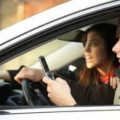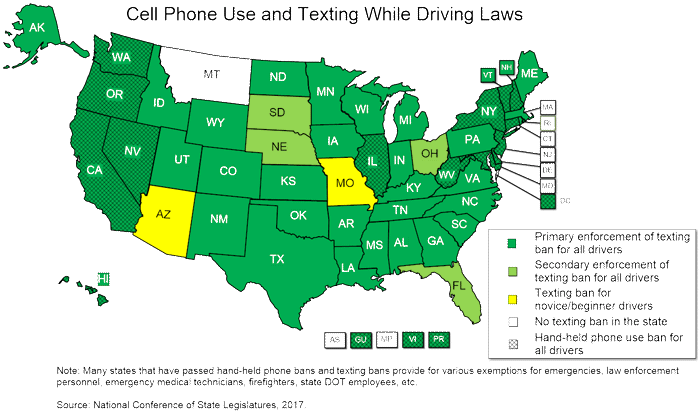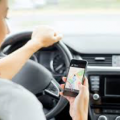Need to Know the Law

Focus on Smartphone Use and Texting While Driving
Distracted driving may involve a host of behaviors that draw the attention of the driver from the road. In addition to cell phone use and texting, they include, among others, talking to other passengers, watching video, changing the radio station, using a GPS, drowsiness, and looking at the scenery. However, with the exception of cell phone use and texting, these behaviors are difficult if not impossible to control through laws or regulation and even more difficult to enforce because law enforcement officers are hard-pressed to prove distracted behavior when stopping a driver. Cell phone use and texting are easier to enforce because the behavior is visible to the officer. Since use of smartphones and texting are the most dangerous forms of distracted driving, and because it is a visible behavior, the focus of lawmakers in attempting to reduce distracted driving has been laws that restrict the use of smartphones and texting while driving. Laws regulating traffic safety are, fundamentally, a state responsibility
The Federal Response to Distracted Driving
While traffic safety laws are a state responsibility, the federal government does have prohibitions of cell phone use and texting while driving for certain categories of drivers. Since 2009 an Executive Order by the President “prohibits federal employees, a workforce of approximately four million people from text messaging while driving on official Government business or while using government-supplied equipment while driving at any other time.” (see J.D. Catherine Chase, above) U.S. State and Federal Laws Targeting Distracted Driving, Association for the Advancement of Automotive Medicine, 2014).
There are also federal rules by the Federal Motor Carrier Safety Administration on Commercial Motor Vehicles (CMVs). According to FMCSA, the, “This rulemaking restricts a CMV (commercial motor vehicle) driver from holding a mobile device to make a call, or dialing by pressing more than a single button. CMV drivers who use a mobile phone while driving can only use a hands-free phone located in close proximity.” https://www.fmcsa.dot.gov/driver-safety/distracted-driving/mobile-phone-restrictions-fact-sheet
The federal government also has voluntary federal guidelines for vehicle makers to limit devices embedded in cars and trucks (GPS, video).
Other than these, there are no national (federal) laws regulating distracted driving. The federal role in curbing smartphone use and texting while driving has been mostly: a) to support research of the effects of smartphone use and texting; b) data collection; c) financial support and incentives of state/local level efforts to enact legislation and education programs; and d) to develop national education campaigns together with a host of community partners across the country.
State Laws
All states have laws in some way restricting the use of cell phones and texting while driving. However, no state bans all cellphone use for all drivers. While the trend among states in enacting laws that limit or prohibit use of cell phones and texting has been to tighten restrictions, laws vary significantly among the various states. In some states, local jurisdictions also have laws or ordinances regulating smartphone and texting while driving, though there is preemptive legislation in most states banning localities from imposing local restrictions on smartphone and texting while driving.
The main differences between the laws among the states are:
- Total vs. Partial Bans: Though no state has a total ban on the use of cellphone and texting, many states have total bans on cell use or texting. All state have partial bans (e.g., prohibit texting but not cellphone use, exceptions such as allowing texting at traffic light stops, bans only when is a school zone);
- Primary vs. Secondary Offense: State law varies among states on whether smartphone use or texting while driving is a “primary” offense, meaning law enforcement can stop a driver using a cellphone or texting as the cause of the stop, while in some states the ban is a “secondary” offense, meaning that the driver must be stopped for another violation first.
Bans on categories of drivers: Some states regulate smartphone use and texting while driving by experienced drivers, but do ban them for all “novice” drivers (usually under 18 years of age).
- Exceptions: States vary in the “exceptions” they make to the ban on cellphone use and texting. Usually, emergency personnel, such as police, firefighters and first responders are exempted in certain circumstances.
The Governors Highway Safety Association (GHSA), the National Conference of State Legislators (NCSL) and the Insurance Institute for Highway Safety (IIHS) compiled smartphone and texting while driving laws by state.
- 15 states, D.C., Puerto Rico, Guam and the U.S. Virgin Islands prohibit all drivers from using hand-held cell phones while driving. (12 and DC Primary Enforcement)
- 38 states and D.C. ban all cell phone use by novice drivers, and 20 states and D.C. prohibit it for school bus drivers.
- Currently, 47 states, D.C., Puerto Rico, Guam and the U.S. Virgin Islands ban text messaging for all drivers. (37 and DC Primary Enforcement,)
- The use of all cellphones by novice drivers is restricted in 38 states and the District of Columbia.
- Of the 47 states and D.C. that ban text messaging while driving, 37 states and D.C. require primary enforcement. Four of the states that ban texting while driving for all drivers have a law that is subject to secondary enforcement. Additionally, some states have partial bans.


Map: Ban handheld devices

Texting Ban Map
https://www.ghsa.org/sites/default/files/2017-07/DistractedDrivingLawChart_July17.pdf
http://www.ncsl.org/research/transportation/spotlight-distracted-driving.aspx
http://www.iihs.org/iihs/topics/laws/cellphonelaws/mapyoungcellbans?topicName=distracted-driving#map
Many localities have enacted their own bans on cellphones or text messaging. In some but not all states, local jurisdictions need specific statutory authority to do so. In addition, most school bus drivers are banned from texting and using hand-held cellphones by state code, regulation or school district policy.
Strictest Distracted Driving Laws
According to various sources, the strictest texting ban laws are in:
- Alaska (up to $10,000 first offense)
- Utah (up to $750 first offense)
- Maine ($500 first offense)
- Wisconsin ($400 up to $800)
- California ($159 first offense)
- Illinois ($120 first offense),
- Massachusetts ($100, $250, $500),
- New York ($150/two points first offense)
- Connecticut ($100, $150, $200)
State by State Safety Information
State safety information on each state can be obtained through the state highway safety office in each state. https://www.ghsa.org/about/shsos
Graduated Driver Licensing
The recent data on distracted driving, smartphone use, and texting while driving point to the effectiveness of Graduated Driver Licensing (GDL) is various states as a tool to reduce smartphone use and texting while driving among youth. Basically, GDL addresses the issue of inexperience and maturity of the young driver. According to the Governors Highway Safety Association, Graduated Driver Licensing (GDL) programs allow young drivers to safely gain driving experience before obtaining full driving privileges. Most programs include three stages:
- Learner Stage: supervised driving, cumulating with a driving test;
- Intermediate Stage: limiting unsupervised driving in high risk situations; and
- Full Privilege Stage: a standard driver’s license.
The GDL sets minimum age requirement for each stage, time the driver must be in each stage and restrictions in each stage (e.g., driving at night for youth under 16)

 Bans on categories of drivers: Some states regulate smartphone use and texting while driving by experienced drivers, but do ban them for all “novice” drivers (usually under 18 years of age).
Bans on categories of drivers: Some states regulate smartphone use and texting while driving by experienced drivers, but do ban them for all “novice” drivers (usually under 18 years of age).